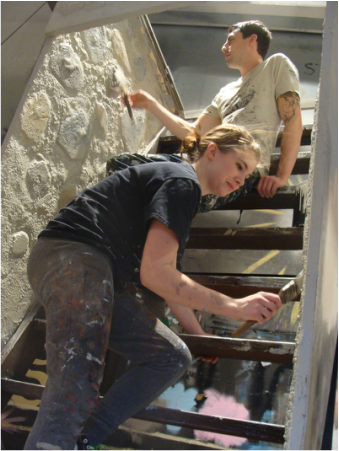
This week in the paint shop, we have been finishing up some loose ends on our upcoming production of King Lear. Here, you can see our Lead Scenic Thayne Abraham painting some faux rocks and coming down from heaven.

For the storm scene in the play, we wanted there to be a storm shelter (sort of Wizard of Oz style) that he could escape into. It was supposed to look like cement with flagstones stuck in it and an old wooden ladder.

The stones were carved from foam, sanded and coated and then painted to give them all the essential highlights and shadows.
Left, Thayne uses his favorite technique, dry brushing to bring out the high points and get the perfect highlight.
The floor of King Lear was especially challenging and exciting. The entire play takes place on a giant antiqued mirror. Below, you can see a slideshow of our progress.
We coated the floor with a near indestructable clear sealer that is industrially used to seal statues and airplanes, and got to work with rags and tinted sealer to create the levels of age at the edges. Scenic Designers can give a paint department several recources from which to work, but the most important, I feel is research. Research can be one or many images taken from books or magazines or the internet of examples of what he/she would like to see. They give us a better understanding of what is in the Designer's head and to get and idea of the feel of what we are painting. Another rescource is the Rendering, or an actual image created by the Designer of exactly what he/she wants to see. Every scrape, every dot of color is planned. We just make this image bigger. It was really interesting to really look at the way a mirror ages. It has so many different colors to it as the backing is peeled away. I really thought there would only be one- perhaps a muddy brown, or even a duller grey. But, as we studied the image, we found soft browns as well as gentle blues and even hot rusty reds and oranges.
The shapes were very organic. We would lay down a glaze and let it set up and then polish some away with a rag or dry brush. Or sometimes we would wait for it to dry completely and scrub some away with a brillo pad or dab some away with alcohol on a cotton swab or rag. And in some instances, we crated a resist with water in a sprayer soon after laying color down.